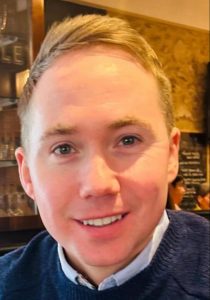 Paul McNamara is a GP in Glasgow and Honorary clinical lecturer at the University of Glasgow.
Paul McNamara is a GP in Glasgow and Honorary clinical lecturer at the University of Glasgow.
Craig MacKay is a 5th year medical student at Glasgow University
What (if anything) happens when we die? This is a question that human beings have been pondering since time immemorial. As health professionals, we come face to face with death every day. She follows us, side by side, an invisible certainty, lurking in our clinics and on our wards. An inevitable consequence of life, the heavy price we must pay for our existence, is the knowledge that one day, we too will die. As a young doctor, I was constantly perplexed by the presence of death and the meaning of life.
I recall a day over a decade ago, where I was talking to a patient who had been on my ward for several weeks. We were chatting as I took blood; then out of the blue, he went into cardiac arrest. Following a prolonged resuscitation attempt, my previously conscious, sentient patient whom I’d got to know, was gone. Dead. Pupils fixed and dilated. No heart sounds. No breath sounds. No response to pain. Life extinct. The body that lay before me, was not the person I was speaking to moments earlier. It was a shell. A vessel. Just a ‘body.’ Where did ‘he’ go?
I didn’t grow up in a religious family. In fact, my dad and his three brothers are staunch atheists. They were positive they knew what happened when we died. As a young impressionable adolescent, the overarching life lesson for my younger brother, my cousins and I can be summed up by the Marlene Dietrich quote; ‘When you’re dead, you’re dead. That’s it.’ If they said that’s what happened when you died, then that was it; I believed it then too. However, now I’m not so sure.
My cousin, Jackie McNamara, ex-Celtic captain and Scotland international footballer, was a hero to me growing up… So, when he shared his recent near-death experience with me, I was both surprised and intrigued.
My family might not be religious, but they are absolutely devoted to football. My cousin, Jackie McNamara, ex-Celtic captain and Scotland international footballer, was a hero to me growing up. Watching him play for Scotland at the World cup in France ’98, is a magical memory that will stay with me forever.
For someone in the public eye, Jackie is a deeply private person. So, when he shared his recent near-death experience with me, I was both surprised and intrigued. Nothing in my undergraduate or postgraduate medical training prepared me to provide him with any answers regarding near-death experiences and consciousness. It all must be brain chemistry, right?*
On the 8th of February 2020, following a relaxing Saturday morning walk, Jackie had a severe, sudden onset headache, and collapsed. He was subsequently rushed to hospital and was found to have a subarachnoid haemorrhage complicated by hydrocephalus. Unfortunately, during a 5-hour surgery, there were complications, and family were called and told that Jackie might not wake up from his medically induced coma.
It was during this period, whilst unconscious from general anaesthesia, when Jackie had a spiritual experience, so profound, that he felt compelled to get baptised some 8 months later.
Whilst medics tried to save his life, Jackie became aware of his surroundings; the only thing was, he was viewing the entire scene from above, looking down on his own body. Suddenly, he found himself transported to a “beautiful, peaceful, garden of healing”. He became one with the Universe and felt surrounded by ‘an immense light’ and he had an overwhelming sense of love and peacefulness.
Jackie remembers every detail about the experience and described it as ‘realer than real.’ At one point, he felt ‘a pressure’ pushing against his face, the ‘bright light’ and then he found himself back in his body, in a hospital bed, surrounded by family.
The term ‘near-death experience’ (NDE) was defined by psychiatrist Dr Raymond Moody in 1975 as the recollection of a transcendental experience in a patient who has recovered from a life-threatening event.1 Although NDE’s are unique for everyone, they usually include similar content regardless of prior faith.2 Contents include an out-of-body experience, followed by a journey through a tunnel into a mystical world of unimaginable beauty.3 Some then undergo a “life review”.2 Patients may also see deceased loved ones, before being offered a choice to stay or return to their physical body.3 Upon choosing – or being forced – to return home, patients re-enter their bodies and wake up, almost always completely transformed, with increased spiritual beliefs and no fear of death.2
The Lancet study, conducted by Dutch Cardiologist Dr Pim Van Lommel, found that approximately 20% of 344 patients who have been resuscitated following cardiac arrest have recalled going through an NDE, with this number increasing exponentially as resuscitation techniques advance.4,5 But what causes so many people, from diverse backgrounds and every constellation of societal strata to have such similar experiences when there should theoretically be limited or no brain function?
For those who have not had an [near-death experience], it may be a difficult concept to understand and accept.
The materialistic theory proposes that consciousness arises from brain physiology. Proponents suggest that NDEs can be explained through neurophysiological mechanisms, such as hypoxia, neurotransmitter reactions, or neurological activity during trauma.6,7
However, critics of the materialistic theory, such as Dr Bruce Greyson, argue that many aspects of NDEs cannot be completely explained by neurological or physical processes. Many patients who have NDEs report heightened awareness and clarity during cardiac arrest; when, by the nature of the event, people are completely ‘unconscious’.8 Dr Pim van Lommel believes that consciousness may exist independently of brain activity following testimonies from patients who can recall detailed experiences during cardiac arrest and argues that consciousness may continue beyond death.9 Dr Raymond Moody emphasises the transformative nature of these experiences and the profound spiritual insights often reported, which challenge purely materialistic interpretations.10
Others have argued that consciousness and NDEs may be explained in part by quantum physics. Noble-prize winning physicist, Professor Sir Roger Penrose suggests that consciousness might emerge from quantum phenomena.11 This perspective proposes that quantum events in the brain could facilitate non-local consciousness experiences. Proponents argue that quantum entanglement—where particles become interconnected—might enable a form of consciousness that transcends physical boundaries, which could explain the profound experiences reported during NDEs.12 Further, some researchers suggest that during NDEs, individuals may experience a dissolution of the ego and a sense of unity with the universe, akin to the interconnectedness described in quantum theory.13
For those who have not had an NDE, it may be a difficult concept to understand and accept. What is certain, like Jackie, more than 95% of those who have a NDE have no doubt what they went through, and state it is “definitely real”.3,14 Many return “changed forever” with no doubts about the existence of an afterlife.2,3 Since his NDE, Jackie feels that he has been profoundly changed by the event and now has no fear about dying.
My medical career has given me the privilege of being with patients at their most vulnerable moments. I have much to learn, but can confidently conclude that death really is a teacher hiding in plain sight. Life is fragile and uncertain. Who knows what, if anything happens when we die? For now, I guess we will just have to wait and see!
*Jackie McNamara has given consent for his experience to be shared.
References
- Psychology Today Staff. Near-Death Experiences, Psychology Today United Kingdom [Internet]. www.psychologytoday.com. [cited 2024 Aug 14]. Available from: https://www.psychologytoday.com/gb/basics/near-death-experiences [accessed 25/10/24]
- Norman AH. Recalled Experience of Death: awareness beyond the brain – BJGP Life [Internet]. Bjgplife.com. 2023 [cited 2024 Aug 14]. Available from: https://bjgplife.com/recalled-experience-of-death/ [accessed 25/10/24]
- Long J. Near-Death Experiences Evidence for Their Reality. Missouri Medicine [Internet]. 2014 [cited 2024 Aug 15];111(5):372–80. Available from: https://www.ncbi.nlm.nih.gov/pmc/articles/PMC6172100/#:~:text=The%20NDERF%20survey %20asked%2C%20%E2%80%9CHow [accessed 25/10/24]
- Hashemi A, Ali Akbar Oroojan, Rassouli M, Hadis Ashrafizadeh. Explanation of near-death experiences: A systematic analysis of case reports and qualitative research. Frontiers in Psychology [Internet]. 2023 Apr 20 [cited 2024 Aug 15];14. Available from: https://www.ncbi.nlm.nih.gov/pmc/articles/PMC10158795/#B99 [accessed 25/10/24]
- van Lommel P, van Wees R, Meyers V, Elfferich I. Near-death experience in survivors of cardiac arrest: a prospective study in the Netherlands. The Lancet [Internet]. 2001 Dec [cited 2024 Sep 9];358(9298):2039–45. Available from: https://www.thelancet.com/journals/lancet/article/PIIS0140-6736(01)07100-8/abstract [accessed 25/10/24]
- Blackmore, S. (1993). Dying to Live: Near-Death Experiences. Guildford Press.
- Parnia, S., Waller, D. G., & Yeates, H. (2014). “A qualitative and quantitative study of NDEs in cardiac arrest patients.” Resuscitation, 85(8), 1107-1112.
- Greyson, B. (2007). “The near-death experience scale: construction, reliability, and validity.” The Journal of Nervous and Mental Disease, 195(2), 30-34.
- van Lommel, P. (2010). Consciousness Beyond Life: The Science of the Near-Death Experience. HarperOne.
- Moody, R. A. (2001). Life After Life: The Investigation of a Phenomenon—Survival of Bodily Death. HarperCollins.
- Penrose, R. (1994). Shadows of the Mind: A Search for the Missing Science of Consciousness. Oxford University Press.
- Hameroff, S., & Penrose, R. (2014). “Consciousness in the universe: A review of the ‘Orch OR’ theory.” Physics of Life Reviews, 11(1), 39-78.
- Stapp, H. P. (2007). “Mind, Matter and Quantum Mechanics.” Foundations of Physics, 37(3), 447-459.Alexander E. Proof of heaven : a neurosurgeon’s journey into the afterlife. 10th year ed. New York, Ny: Simon & Schuster Paperbacks; 2022.
- Alexander E. Proof of heaven: a neurosurgeon’s journey into the afterlife. 10th year ed. New York, Ny: Simon & Schuster Paperbacks; 2022.
Featured image by Dan Meyers on Unsplash







Thank you for this. Until we start to incorporate a respect and reverence for the unknown and unexplained that is after death and before birth (explained in actual fact comprehensively in the core teachings of all great religions -once the dogma and distortion has been stripped away) we will be offering a partial medicine that cannot solve the well-being crisis we are currently experiencing.